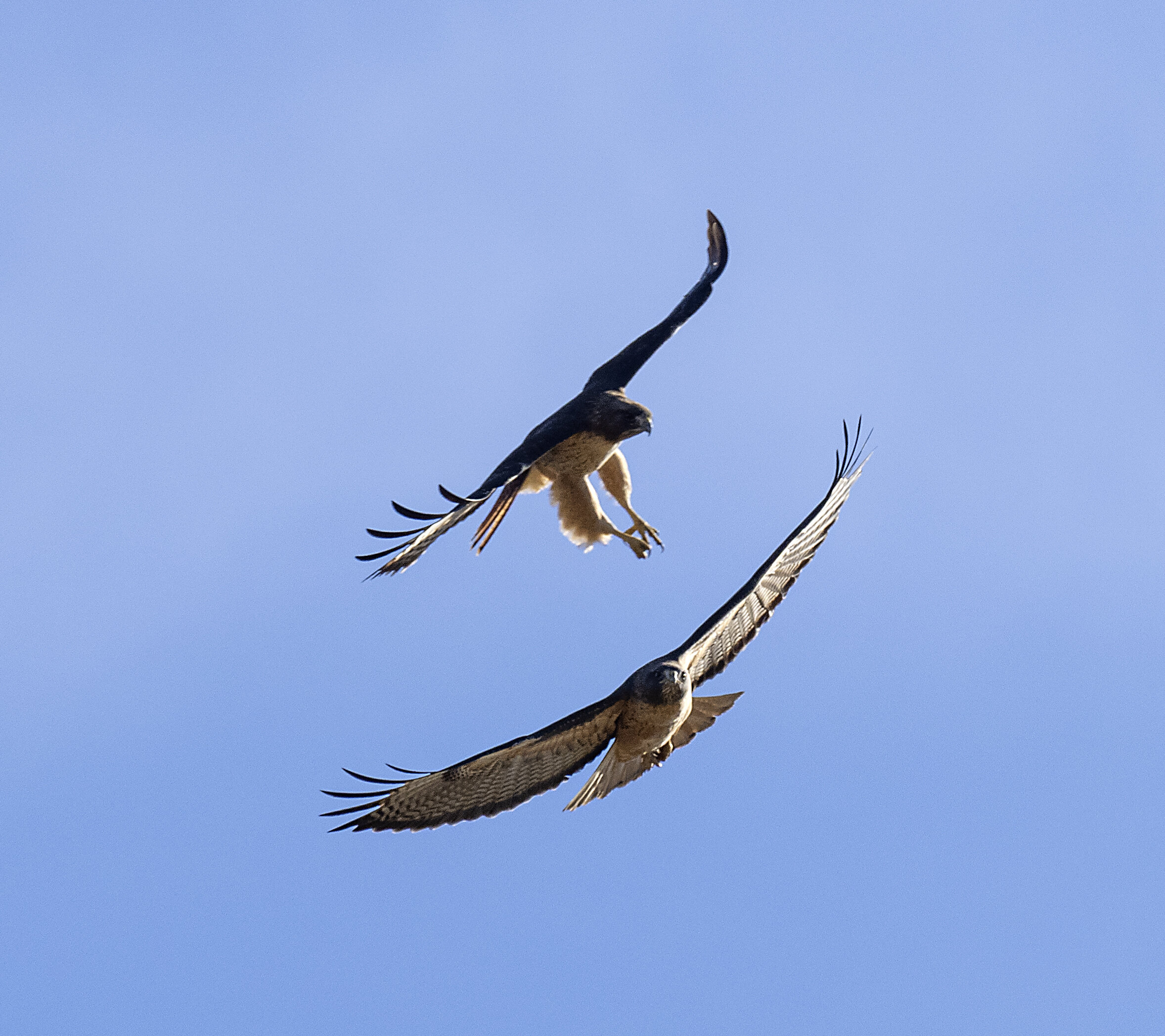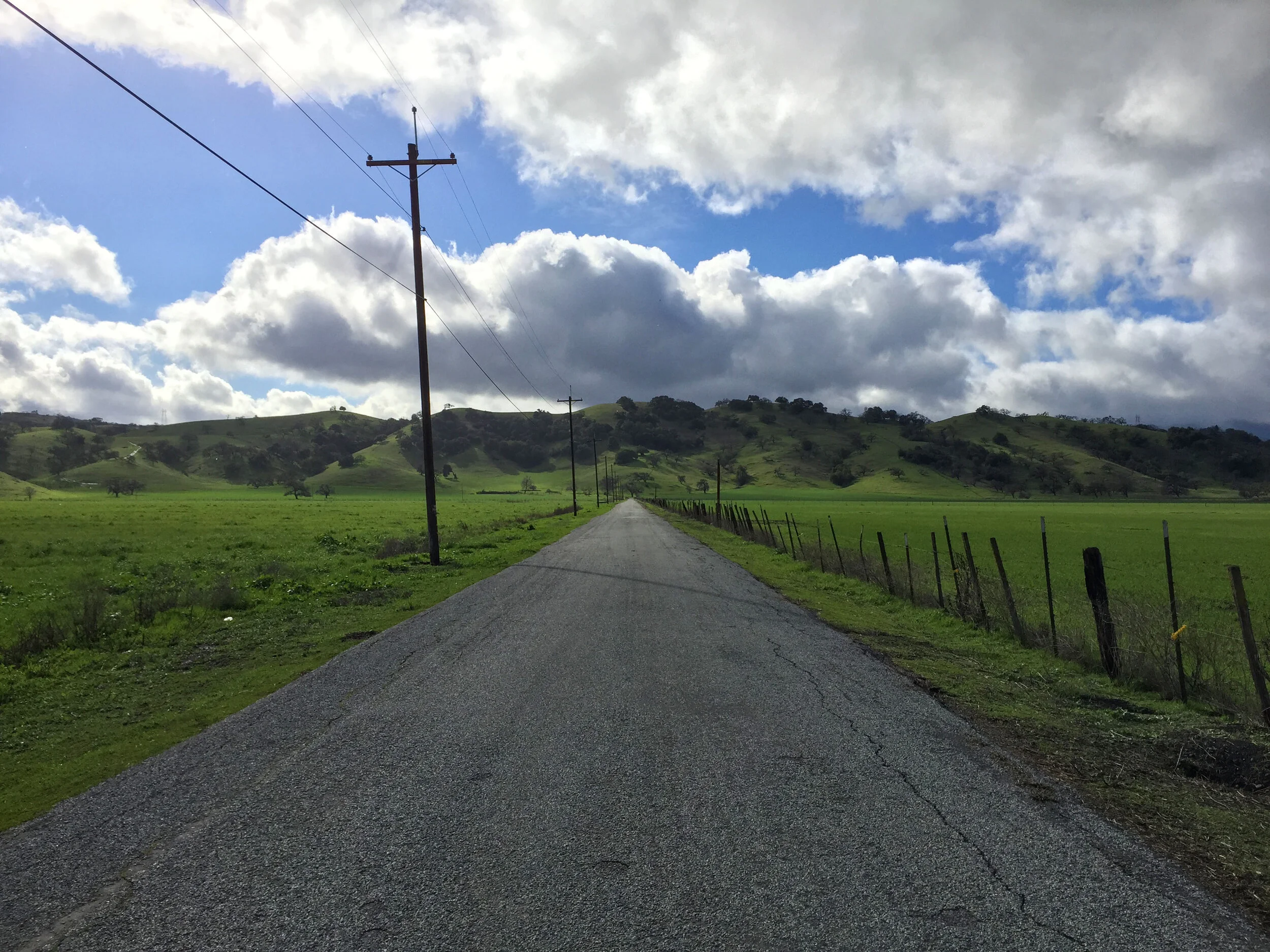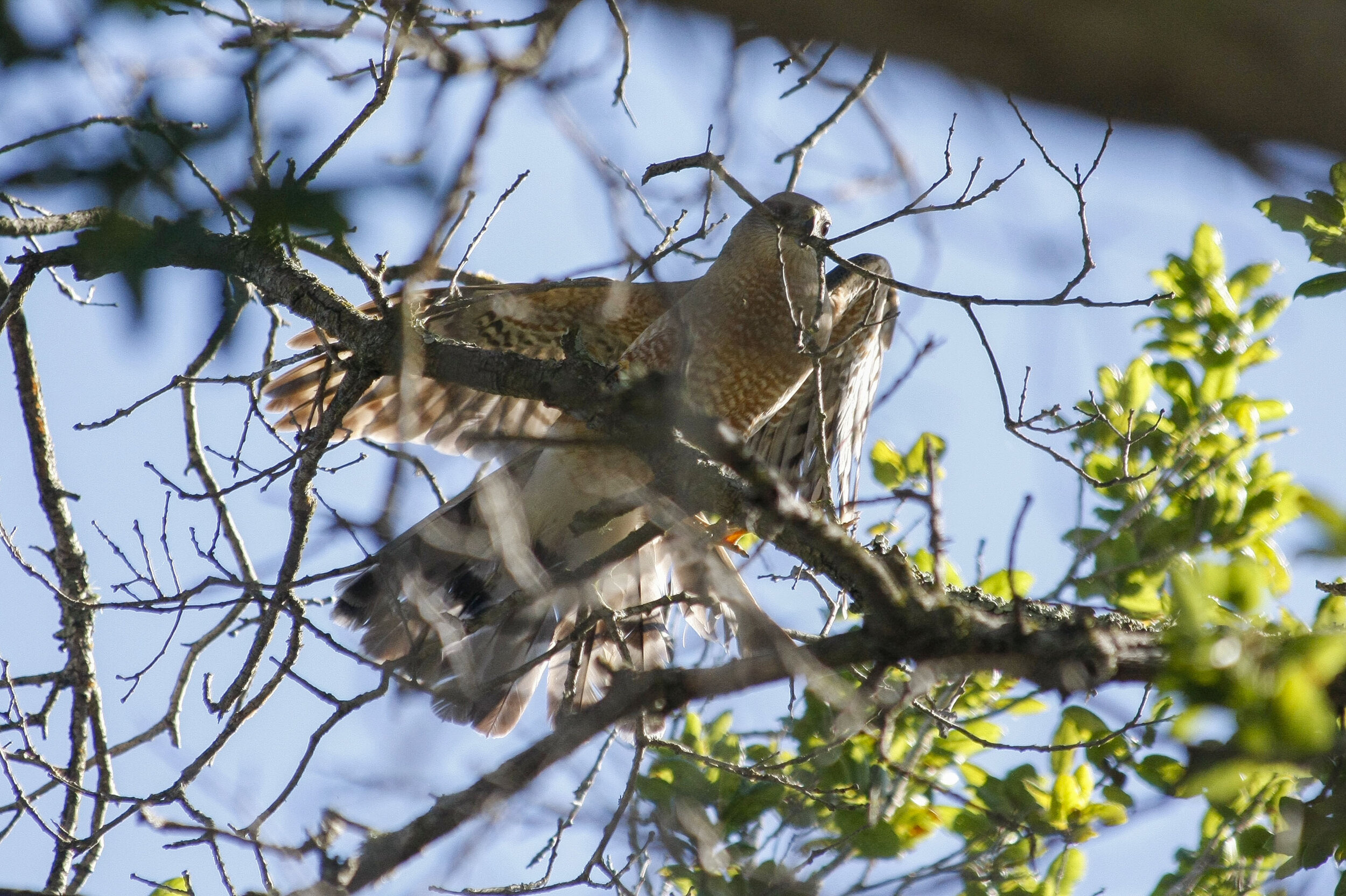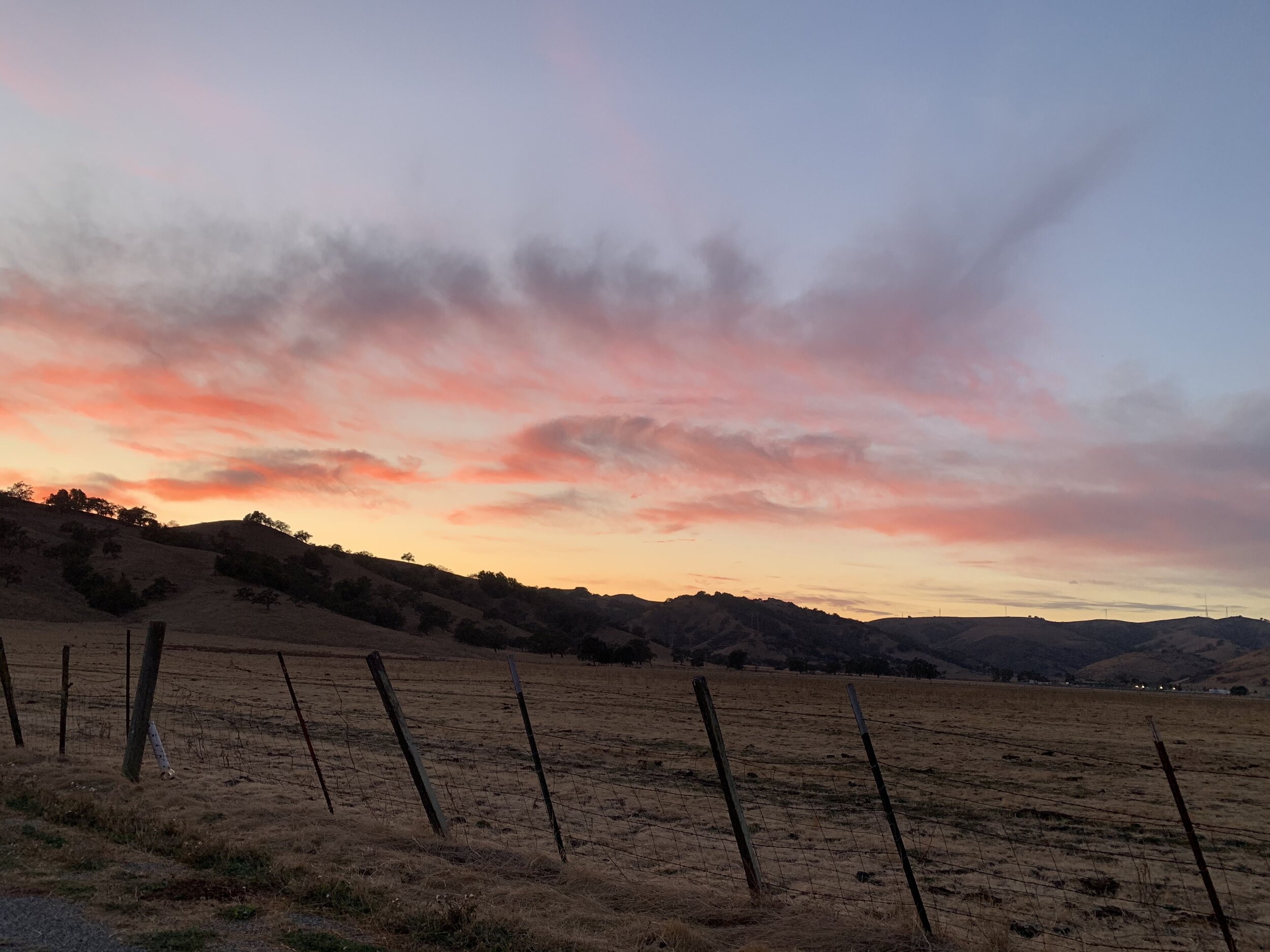Coyote Valley (Late Winter/Early Spring):
Love & Raptors in the Air
by Dani Christensen
With the shadow of winter solstice behind us, we see the days lengthening and the grasses greening. By February, the Western Meadowlarks are singing their liquid songs, insects take flight in the warm winter sun, and the mustards and milkmaids are blooming. Long before this though, raptors begin “courting” in winter. That is, they are either re-establishing pair bonds or making new ones. This can be anything from two birds perching near each other, engaging in courtship “dances”, right up to the act of copulation. In this trip we will bird the Coyote Valley floor in South San Jose/Morgan Hill, paying special attention to the antics of birds of prey as they kick off the breeding season. This trip is best done by car or by bike, as it involves scanning long sections of fields along roads.
Two Red-tailed Hawks engaging in a courtship flight. The smaller male (top) will hang his legs down and cruise above the larger female (bottom), sometimes even touching her with his talons or interlocking talons and spinning down towards the ground before breaking apart, avoiding impact. Photo by Deanne Tucker.
Trip Covers: January - March
Key Birds: Northern Harrier, Ferruginous Hawk, Say’s Phoebe, Loggerhead Shrike, Tricolored Blackbird
How to Bird
The agricultural fields of Coyote Valley are excellent birding for raptors and grassland specialties. Santa Teresa Blvd/Hale Ave and Monterey Hwy run parallel down the length of Coyote Valley, and any of the avenues off this main line are great to explore. Other Self-Guided Trips cover the Coyote Creek Trail, which also runs though the valley (see list in “Ready for More?”). This trip will cover the roads branching off Santa Teresa Blvd from Bailey Ave south to Palm Ave, mainly Laguna Ave but also Richmond, Dougherty, and Palm Ave.
Besides cattle, the agricultural fields on either side of Laguna Ave often have cool birds, too! The road dead ends to the west against the foothills of the Santa Cruz Mountains. On the other side of the ridge pictured is Calero County Park and Rancho Cañada del Oro. Photo by Dani Christensen.
Long before roads and paved bike trails, the Muwekma Ohlone and Amah Mutsun people called Coyote Valley home, the valley being a sort of “transitional” land between the two peoples’ territories. The land since has seen land acquisition from Spanish Land Grants, and in more recent history was slated for industrial, commercial, and residential development. Conservation groups are still fighting hard to preserve this landscape, as it’s the last relatively undeveloped stretch of land in Santa Clara Valley, and is critical habitat for native wildlife.
Begin your trip by arriving at Laguna Avenue [Interactive Map Stop 1], heading West off of Santa Teresa Blvd. Slow down before driving over Fisher Creek in front of you, scanning the field on your left for Great Egret, Great Blue Heron, Common Ravens and American Crows. You can stay in your car or you can park and get out. Either way, just be sure you’ve pulled over enough for a car to go by. This road is not busy, with only a few residences; all the more reason to be courteous! You’ll want to start looking out for raptors; White-tailed Kites and Red-Shouldered Hawks are often seen in the cottonwoods and willows along the creek, and a Red-tailed Hawk or two are sometimes in the bigger tree above the house on your left.
Look for Kite courtship behavior: they will engage in a “flutter flight”, when a pair or just the male will flap their wings shallowly and quickly, often hanging their legs down too. Males will present females with prey as a gift, sometimes exchanging dramatically mid-air. Photo by Tom Grey.
Crossing Fisher Creek [2], look and listen for Lincoln’s (leaving the county soon for its breeding grounds!) and Song Sparrow as well as the crowned sparrows near the thickets. After learning the metallic call note of the Lincoln’s Sparrow, this sneaky sparrow becomes easier to locate. Savannah Sparrow can be seen along the road, flushing from your car as you move along and perching on the barbed wire fences lining both sides of the road. American Pipits can also be seen foraging on the ground in the open fields, but they can be difficult to spot as they are so well camouflaged.
American Pipits can be tough to find in the grass, but have patience and soon you might see many moving around on the ground! Photo by Dani Christensen.
After crossing the creek you’ll see the expansive fields to your left and right. Drive slowly and you’ll soon see gobs of blackbirds on the wires along the road as well as in the field. Possibilities include Red-winged Blackbird, European Starling (a black bird, but not a blackbird!), Brown-headed Cowbird, Brewer’s Blackbird, and a California Species of Special Concern: the Tricolored Blackbird. Don’t forget the more colorful and melodious blackbird, the Western Meadowlark. Say’s Phoebe will be around until about April; look for them flycatching from perches on the fences or tall fallow weeds. Scan any groups of Canada Geese for late wintering geese like Cackling, Greater White-fronted, Snow, or Ross’s. After a good rain, you may see ducks and shorebirds out here, too.
American Kestrels nest in cavities, possibly in the craggy Valley Oaks in the foothills to the west. Courtship behavior includes “fluttering” flight, dramatic diving displays, and prey exchanges between the pair. Photo by Robert Martinez.
Scan all wires, towers, fenceposts and trees for perched raptors. A scope is handy for getting the distant perches. All diurnal raptors seen in the county are possible on Laguna Ave with the right conditions, lots of patience, and luck.
American Kestrel are commonly on the wires and at least two pairs call Laguna West home. One can have the coveted Four-Falcon day here in winter: American Kestrel, Merlin, Prairie Falcon, and Peregrine. Merlins are strictly winter visitors, and Prairie Falcons are rare breeders in the Diablo foothills. Peregrines have become more common year-round in the county after successful regulations against poaching and pesticides, and will hunt the many ducks and blackbirds in Coyote Valley. They are most often seen in winter, and are a less common breeder. One famous exception: the San Jose City Hall Peregrines, Grace and her mate Hopper 2. Mating has already begun! Click the link for more information and live camera feeds. Typically nesting on cliffs, it seems that the tall buildings of Silicon Valley are a suitable alternative for these birds.
Ferruginous Hawks like this one are winter visitors from interior grasslands of the Great Plains and arid West. They come in two morphs, light and dark. This one is a light morph due to its predominately white undersides. Adults have rufous-feathered legs, something this juvenile bird lacks. Photo by Dani Christensen.
Continue driving down Laguna. It dead-ends at the foothills of the Santa Cruz Mountains. I like to park and get out a few times as I make my way down the road; it’s up to you. High above, you may hear the screaming call of the ubiquitous Red-tailed Hawk and see two or more circling together doing their leg-hanging display. Raptors typically mate for life, and often re-use old nest sites. Keep an eye out for birds carrying sticks, a sign that they are refurbishing or creating a nest.
Ferruginous Hawks are winter visitors, and there is no clear evidence as to whether they migrate in pairs or not. On breeding grounds, they perform similar courtship dances to the Red-Tailed Hawk: leg hanging-displays and “sky-dances”, described as diving and ascending over and over in the sky. Look for these beautiful Buteos on the fenceposts or the ground hunting ground squirrels and rabbits. Northern Harrier are also common here, flying low over the fields.
Normally solitary, these two Golden Eagles were seen perched together on a communication tower, a sign of courtship. The much bigger female is the bird on the right. There are a few hypotheses for this sexual size difference, one being that females use their bigger body to “bully” their mate out of food while on the nest. Photo by Dani Christensen.
Golden Eagles (year-round) and Bald Eagles (winter) are sometimes seen soaring above Laguna Avenue. Golden Eagles nest in the mountains of the Diablo Range to the east but also in the western foothills; look for signs of courtship such as pairs soaring together, undulating flights, perching conspicuously and next to each other, and carrying and dropping objects like prey. Bald Eagles engage in dazzling displays, including the “Cartwheel Display” in which a pair locks talons and tumbles towards the ground, breaking away in the nick of time. Bald Eagles were not known to nest in Santa Clara County until 2006, when a nest was discovered at Calaveras Reservoir. Now, every large reservoir in the county potentially hosts a breeding pair of Baldies.
Let’s not forget the Turkey Vulture and honorary raptor the Loggerhead Shrike! Both are common here as well. Look for Shrikes on the fence lines parallel and perpendicular to Laguna Ave. Osprey are uncommon, but it is possible to catch one soaring in the distance, on its way to and from freshwater ponds along Coyote Creek. Burrowing Owl and Short-Eared Owl have been seen on these fields in the past, but it’s been a few years. Maybe you’ll find one!
Cooper’s Hawk taking off with a stick. Watch for raptors and other birds carrying nest material, and see if you can find where they go! But remember to give nesting birds ample space so they can raise young in peace. Photo by Dani Christensen.
After checking the foothills for oak woodland birds including the enigmatic Yellow-Billed Magpie, turn around at the end of the road [3]. There is a little more space here at the end for larger vehicles to turn around. If you’ve got the time, doing a driving transect of the other roads in Coyote Valley is worth it for a chance at birds you may have missed on Laguna Ave, such as Sharp-shinned and Cooper’s Hawks. Coyote Valley often turns up rarities such as a Vermillion Flycatcher, Cassin’s Kingbird, Mountain Bluebird and Cattle Egret.
Head back out on Laguna Ave and cross Santa Teresa. This east side of Laguna Ave [4] seems to be good hunting habitat for Peregrines lately. Go all the way to the end, going slow and pulling over for grassland birds and raptors. Turn around, and make a left (south) back onto Santa Teresa and head to Richmond Ave. Make a left onto Richmond and scan the big trees [5] for Great Horned Owl. Again, go to the end and turn around.
Get back on Santa Teresa and keep heading south, and make a left on Palm Ave East [6]. Keep your eye peeled for Ferruginous Hawk; they tend to roost on this side of Palm. Explore Dougherty Ave [7] for good chances at Great-tailed Grackle and the other roads like Scheller [8] for neighborhood birds like California Towhee and Anna’s Hummingbird. Explore the roads at your leisure, making sure to pull over when you can to let other cars pass. Try this trip pre-dawn or dusk for owling, or mid-morning for soaring raptors riding the thermals.
Sunset on Laguna Ave. Photo by Dani Christensen.
Ready for More?
Coyote Valley Open Space Preserve is a wonderful hotspot on west Palm Ave with a hiking loop that takes you into the foothills. Don’t forget to bird the road going in for Killdeer and blackbirds. A Burrowing Owl can sometimes be seen here in winter. The Coyote Creek Trail is a nice flat bike trail along the riparian corridor, a great place for birding with many places to drop in. Ogier Ponds is a wonderful spot to look for remaining wintering ducks and gulls, with better chances at Bald Eagle and Osprey. Laguna Seca Wetlands are just north of Bailey Ave, recently acquired by the Santa Clara Valley Open Space Authority. The preserve won’t be open to the public for awhile, but you can try scoping the wetlands from a pullout at the top of Santa Teresa Blvd [9]. Just be careful for cars as you come and go; people like to speed here!
Interactive Map
Directions: On US-101, head south towards Morgan Hill. Exit Bailey Ave. Turn right onto Bailey Ave, then make a left on Santa Teresa Blvd. Laguna Ave will be on your right. If you’re coming from Morgan Hill/Gilroy, exit US-101 at Bailey and turn left onto Bailey, left on Santa Teresa, and finally right on Laguna Ave. Latitude/Longitude: 37.190756, -121.732321
Parking: Street parking, often pulling over on dirt pullouts
Fees: None
Public Transportation: VTA Bus Route 68 runs down Santa Teresa Blvd/Hale Ave, providing access to the Santa Teresa Light Rail Station and Gilroy Transit Center.
Park and/or Trail Hours: None
Facilities: None. Pit toilet at the nearby CVOSP on Palm Ave
Trip Mileage: Mileage may vary: 3 to 8 miles. Exploring only Laguna Ave West is 1.5 miles out-and-back.
Trail Conditions: Paved road and paved or dirt pullouts
Accessibility: It is possible to do this entire trip from the comfort of an accessible vehicle.
Bikes: Possible to do by bike
Dogs: Dogs allowed on public roads
More Information
eBird hotspots Coyote Valley, Palm Ave, Richmond Ave, and Laguna Ave
Read more about Coyote Valley
Learn more about Tricolored Blackbird Conservation
Other Self-Guided Fields trips in Coyote Valley: Ogier Ponds and Coyote Valley OSP
More Resources
For more trips like this one, visit Self-Guided Field Trips.
Visit the SCVAS Birding Resources page for more information on where to bird, our birding community, bird identification resources and more.
Read “What to Look for Now” by SCVAS Executive Director Matthew Dodder.
Banner Photo Credit: Coyote Valley by Dani Christensen
Last Updated: 04/19/2022
Enjoyed this Trip?
Support the work of Santa Clara Valley Audubon Society and become a member. To contact the trip writer with comments, questions or location updates, please email fieldtrips@scvas.org. You can also post in the comment section below. (If you’d like to post anonymously, type your comment, select “Post Comment”, then simply provide a name, like “Guest”, and select “Comment as Guest”.)










